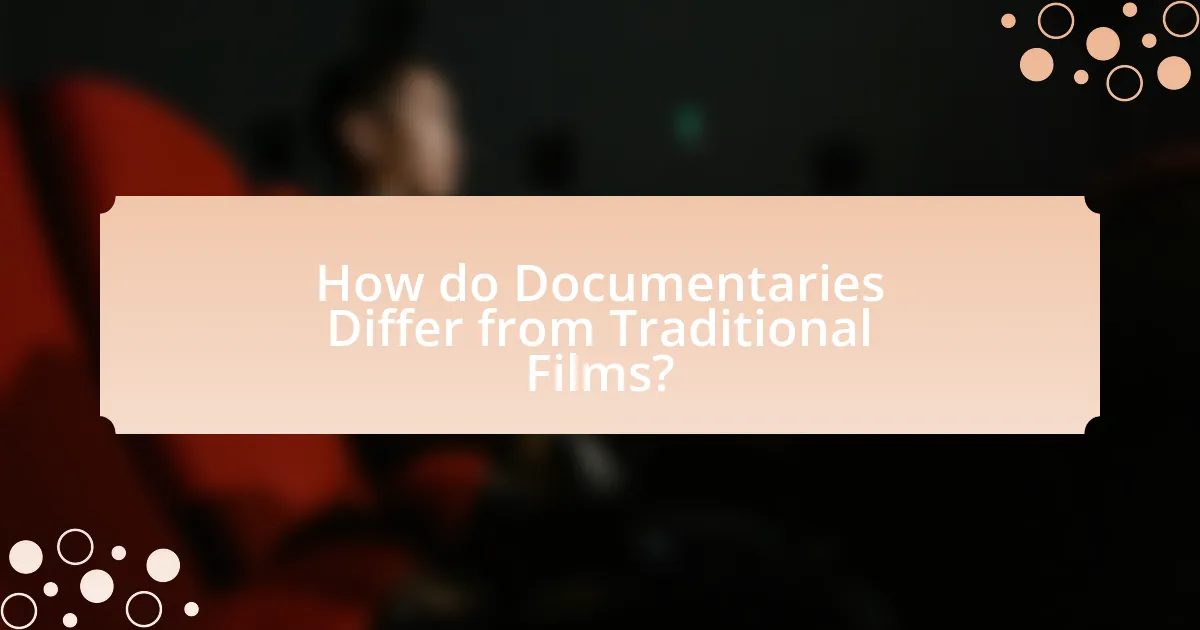Documentaries represent a distinct genre in filmmaking that prioritizes factual storytelling and real-life events, contrasting sharply with traditional films that focus on fictional narratives. This article explores how documentaries challenge conventional film review formats by emphasizing authenticity, social relevance, and emotional engagement over traditional criteria such as narrative structure and character development. It examines the unique characteristics of documentaries, their rising popularity in modern cinema, and the implications for film criticism, highlighting the need for critics to adopt new evaluative standards that reflect the genre’s commitment to truth and societal impact. Additionally, the article discusses the evolving expectations of audiences regarding documentary reviews and the best practices critics should employ to effectively analyze this genre.

How do Documentaries Differ from Traditional Films?
Documentaries differ from traditional films primarily in their purpose and approach to storytelling. Documentaries aim to present factual information and real-life events, often using interviews, archival footage, and observational techniques to convey their message, while traditional films typically focus on fictional narratives, character development, and entertainment. For instance, the documentary “13th” by Ava DuVernay explores the history of racial inequality in the United States through a factual lens, contrasting with a traditional film like “The Godfather,” which centers on a fictional crime family. This distinction highlights how documentaries prioritize authenticity and education over narrative escapism, making them a unique genre in the film landscape.
What are the defining characteristics of documentaries?
Documentaries are characterized by their commitment to presenting factual information and real-life events. They often utilize interviews, archival footage, and observational techniques to convey their narratives, aiming to inform, educate, or provoke thought among viewers. For instance, the documentary “13th” by Ava DuVernay employs a mix of historical footage and expert interviews to explore the intersection of race, justice, and mass incarceration in the United States, illustrating how documentaries can effectively engage with complex social issues.
How do these characteristics influence audience perception?
Characteristics such as authenticity, emotional engagement, and factual storytelling significantly influence audience perception by fostering trust and relatability. When documentaries present real-life events and personal narratives, they create a connection that resonates with viewers, making the content more impactful. Research indicates that audiences are more likely to engage with and remember information presented in a narrative format, as evidenced by a study published in the journal “Cognitive Science,” which found that stories enhance memory retention by up to 22%. This emotional and cognitive engagement leads to a deeper understanding and appreciation of the subject matter, ultimately shaping how audiences perceive the documentary’s message and its relevance to their own lives.
What narrative techniques are unique to documentaries?
Documentaries utilize unique narrative techniques such as direct address, observational storytelling, and the use of archival footage. Direct address involves the filmmaker or subjects speaking directly to the audience, creating a personal connection and enhancing engagement. Observational storytelling captures real-life events as they unfold, allowing viewers to witness authenticity without scripted dialogue. The incorporation of archival footage provides historical context and supports the narrative by grounding it in factual evidence. These techniques differentiate documentaries from traditional films, which often rely on scripted narratives and fictional characters.
Why are documentaries gaining popularity in modern cinema?
Documentaries are gaining popularity in modern cinema due to their ability to engage audiences with real-life stories and issues. This genre offers viewers authentic narratives that resonate on a personal level, often addressing social, political, and environmental topics that are increasingly relevant in today’s society. According to a 2021 report by the Documentary Organization of Canada, the demand for documentary content has surged, with streaming platforms like Netflix and Amazon Prime investing heavily in original documentary programming, reflecting a 50% increase in viewership over the past five years. This trend indicates that audiences are seeking more meaningful content that informs and inspires, further solidifying the documentary’s place in contemporary cinema.
What societal trends contribute to the rise of documentaries?
The rise of documentaries is primarily driven by increased public interest in authentic storytelling and social issues. This trend is fueled by the proliferation of digital media platforms, which provide easy access to diverse documentary content. According to a 2021 report by the Pew Research Center, 73% of Americans believe that documentaries help them understand complex issues better, indicating a societal shift towards valuing factual narratives. Additionally, the growing demand for transparency and accountability in various sectors, including politics and corporate practices, has led audiences to seek out documentaries that expose truths and provide in-depth analysis. This combination of factors has significantly contributed to the popularity and production of documentaries in contemporary society.
How do documentaries engage with current events and issues?
Documentaries engage with current events and issues by providing in-depth analysis and real-life perspectives that highlight societal challenges and developments. They often utilize interviews, archival footage, and expert commentary to present factual narratives that inform viewers about pressing topics, such as climate change, social justice, and political unrest. For instance, the documentary “13th” by Ava DuVernay explores the intersection of race, justice, and mass incarceration in the United States, effectively linking historical context to contemporary issues. This approach not only raises awareness but also encourages critical thinking and dialogue among audiences, making documentaries a powerful medium for engaging with current events.

In what ways do Documentaries Challenge Traditional Film Review Formats?
Documentaries challenge traditional film review formats by prioritizing factual storytelling over narrative structure, which alters the criteria for evaluation. Unlike fictional films, documentaries often focus on real events, people, and issues, requiring reviewers to assess authenticity, impact, and educational value rather than just entertainment quality. This shift necessitates a different analytical approach, emphasizing critical thinking and context over plot development and character arcs. For instance, the documentary “13th” by Ava DuVernay critiques systemic racism in the U.S. criminal justice system, prompting reviewers to engage with its socio-political implications rather than merely its cinematic techniques. Thus, documentaries redefine the parameters of film critique, emphasizing truth and relevance over traditional storytelling metrics.
How do traditional film review formats differ from documentary reviews?
Traditional film review formats primarily focus on narrative structure, character development, and entertainment value, while documentary reviews emphasize factual accuracy, subject matter relevance, and the impact of real-world events. Traditional reviews often assess films based on storytelling techniques and emotional engagement, whereas documentary reviews prioritize the authenticity of the content and the effectiveness of the filmmaker’s message. This distinction is evident in the language used; traditional reviews may employ more subjective language, while documentary reviews tend to be more analytical and objective, reflecting the documentary’s purpose of informing or educating the audience about real issues.
What criteria are typically used in traditional film reviews?
Traditional film reviews typically use criteria such as narrative structure, character development, cinematography, direction, and thematic depth. These elements are essential for evaluating the overall quality and impact of a film. For instance, narrative structure assesses how well the story is constructed and whether it engages the audience, while character development examines the complexity and relatability of the characters. Cinematography focuses on the visual composition and technical execution, and direction evaluates the filmmaker’s ability to convey the story effectively. Thematic depth considers the underlying messages and social commentary presented in the film. These criteria provide a comprehensive framework for critics to analyze and articulate their perspectives on films.
How do these criteria apply or not apply to documentaries?
Documentary films often challenge traditional film review criteria by prioritizing factual accuracy and real-world representation over narrative structure and character development. Unlike fictional films, documentaries focus on presenting truth, which can lead to a different set of evaluative standards, such as the credibility of sources and the authenticity of the depicted events. For instance, the documentary “13th” by Ava DuVernay effectively uses historical data and expert interviews to support its arguments about systemic racism in the U.S. prison system, demonstrating how factual integrity is a critical criterion for evaluation in documentaries. This emphasis on factual representation can sometimes conflict with traditional narrative criteria, which may prioritize storytelling techniques over the accuracy of information presented.
What unique challenges do critics face when reviewing documentaries?
Critics face unique challenges when reviewing documentaries due to the genre’s reliance on factual representation and the ethical implications of storytelling. Documentaries often present real-life events and individuals, which requires critics to navigate the balance between artistic interpretation and factual accuracy. This challenge is compounded by the need to assess the filmmaker’s perspective and potential biases, as documentaries can shape public perception of the subjects they portray. Additionally, critics must consider the emotional impact of the documentary on audiences, which can vary widely based on personal experiences and cultural contexts. These factors make it essential for critics to approach documentary reviews with a nuanced understanding of both the content and the broader implications of the narratives presented.
How does the subjectivity of documentaries affect critical analysis?
The subjectivity of documentaries significantly impacts critical analysis by influencing the interpretation of content and the perceived credibility of the filmmaker’s perspective. Documentaries often present a specific viewpoint, which can lead to biased representations of facts and events. This bias affects how critics assess the documentary’s accuracy and reliability, as they must navigate the filmmaker’s intentions and the emotional resonance of the narrative. For instance, a study by Bill Nichols in “Introduction to Documentary” highlights that the subjective choices made in documentary filmmaking, such as selective editing and narrative framing, shape audience understanding and critical reception. Consequently, critics must consider these subjective elements when evaluating the documentary’s effectiveness and truthfulness, leading to a more nuanced and complex analysis.
What role does factual accuracy play in documentary reviews?
Factual accuracy is crucial in documentary reviews as it establishes the credibility and reliability of the documentary’s content. Documentaries aim to present real events, people, and issues, and inaccuracies can mislead audiences and distort understanding. For instance, a review that highlights factual inaccuracies can alert viewers to potential biases or misrepresentations, thereby influencing their perception of the documentary’s integrity. Research indicates that audiences are more likely to trust documentaries that are factually accurate, as evidenced by a study published in the Journal of Media Ethics, which found that viewers rated documentaries higher when they perceived them as truthful and well-researched. Thus, factual accuracy not only shapes the review process but also impacts audience engagement and trust in the documentary genre.

What Impact do Documentaries Have on Film Criticism and Audience Reception?
Documentaries significantly influence film criticism and audience reception by introducing new narrative structures and factual storytelling that challenge conventional cinematic norms. This impact is evident as critics often reassess traditional criteria for evaluating films, focusing more on authenticity, social relevance, and emotional engagement rather than solely on artistic merit or entertainment value. For instance, the rise of documentaries like “13th” and “Won’t You Be My Neighbor?” has prompted discussions around social justice and personal connection, reshaping audience expectations and critical analysis. Research indicates that documentaries can evoke stronger emotional responses, leading to increased viewer engagement and a shift in how audiences perceive the role of film in societal discourse.
How do documentaries influence audience expectations of film reviews?
Documentaries influence audience expectations of film reviews by providing a factual and immersive narrative that shapes viewers’ perceptions of authenticity and credibility in storytelling. Audiences often expect film reviews to reflect the same level of depth and insight found in documentaries, which typically emphasize real-life events and thorough research. This expectation is supported by the rise of documentary filmmaking, which has increased public awareness of social issues and historical contexts, leading viewers to seek similar analytical perspectives in film critiques. Consequently, when reviewing narrative films, audiences may anticipate a critical examination of themes and truths akin to those presented in documentaries, thereby challenging traditional review formats that may prioritize entertainment over substance.
What shifts in audience engagement can be observed with documentary reviews?
Shifts in audience engagement with documentary reviews include increased interactivity and a greater emphasis on community discussion. Audiences are now more likely to engage with documentary content through social media platforms, where they share opinions and insights, fostering a communal viewing experience. Research indicates that 70% of viewers discuss documentaries online, compared to 50% for traditional films, highlighting a significant shift in how audiences connect over documentary content. This engagement is further enhanced by the accessibility of streaming platforms, which allow for immediate feedback and interaction, thus transforming the traditional passive viewing experience into an active dialogue.
How do documentaries reshape the conversation around film criticism?
Documentaries reshape the conversation around film criticism by introducing new narrative structures and perspectives that challenge conventional storytelling. Unlike traditional films, documentaries often prioritize factual representation and real-world issues, prompting critics to evaluate films based on authenticity and social impact rather than solely on artistic merit. This shift encourages a broader discourse that includes ethical considerations and the role of filmmakers as storytellers of reality. For instance, the rise of documentaries like “13th” by Ava DuVernay has sparked discussions on systemic racism, illustrating how documentaries can influence public opinion and critical analysis by addressing pressing societal issues.
What best practices should critics adopt when reviewing documentaries?
Critics should adopt a comprehensive approach that includes contextual analysis, thematic exploration, and ethical considerations when reviewing documentaries. Contextual analysis involves understanding the historical and cultural background of the documentary’s subject matter, which enhances the review’s depth. Thematic exploration requires critics to identify and discuss the central themes presented in the documentary, allowing for a richer interpretation of the filmmaker’s intent. Ethical considerations are crucial, as critics must evaluate the documentary’s representation of subjects and the potential impact on audiences, ensuring that the review reflects a responsible critique. These practices are supported by the growing recognition of documentaries as complex narratives that require a nuanced understanding, as highlighted in studies on documentary storytelling and audience engagement.
How can critics balance factual reporting with artistic interpretation?
Critics can balance factual reporting with artistic interpretation by employing a dual approach that emphasizes both objective analysis and subjective experience. This involves clearly distinguishing between the factual elements of a documentary, such as its subject matter, sources, and context, while also articulating personal interpretations of its artistic choices, such as cinematography, narrative structure, and emotional impact. For instance, a critic might report on the accuracy of the documentary’s claims regarding historical events while also discussing how the filmmaker’s stylistic decisions enhance or detract from the viewer’s understanding of those events. This method allows critics to provide a comprehensive review that respects the integrity of the documentary’s content while also acknowledging the creative aspects that contribute to its overall effectiveness.
What resources are available for critics to enhance their documentary reviews?
Critics can enhance their documentary reviews through various resources, including academic journals, film analysis books, and online platforms dedicated to documentary filmmaking. Academic journals such as “The Journal of Film and Video” provide peer-reviewed articles that explore documentary theory and critique, offering critics a scholarly perspective. Film analysis books, like “Documentary: A History of the Non-Fiction Film” by Erik Barnouw, provide historical context and critical frameworks that can deepen understanding. Online platforms such as Documentary.org and the International Documentary Association offer articles, interviews, and resources that keep critics informed about current trends and practices in documentary filmmaking. These resources collectively equip critics with the knowledge and tools necessary to produce insightful and informed reviews.